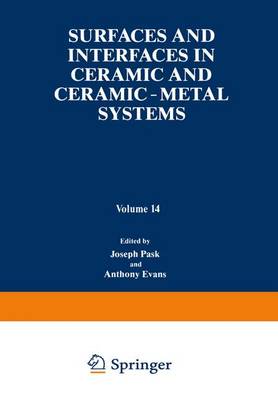Materials Science Research
2 primary works
Book 14
Surfaces and Interfaces in Ceramic and Ceramic-Metal Systems
by Joseph Pask and Anthony Evans
Published 30 June 1981
The 17th University Conference on Ceramics, which also was the 7th LBL/MMRD International Materials Symposium, was held on the campus of the University of California at Berkeley from July 28 to August 1, 1980. It was devoted to the subject of surfaces and interfaces in ceramic and ceramic-metal systems. The program was timely and of great interest, as indicated by the large number of contributed papers, which included contributions from ten foreign countries. These proceedings are divided into the following categories dealing with the chemistry and physics of interfaces: calculations of interface/surface states, characterization of surfaces and inter faces, thermodynamics of interfaces, influence of surface and inter faces on selected ceramic processes, grain boundary structures, effects of grain boundaries on deformation and fracture, interfacial phenomena, formation of interfaces, development of adhesion, and reactions at interfaces. A number of papers deal specifically with the Si-Si02 interface, which probably has received more attention than any other because of its importance in the electronics industry. This coverage fulfills the principal objective of the symposium which was to explore and assess the current fundamental understand ing of interfaces and surfaces. A parallel objective of the symposium was fulfilled by a group of papers dealing with the correlation of interfacial characteris tics with mechanical behavior. This group includes papers dealing with the adherence of dissimilar materials at interfaces.
Book 21
The Proceedings of the International Materials Symposium on Ceramic Microstructures '86: Role of Interfaces presents a comprehensive coverage of the past decade's advances in ceramic science and technology related to microstructures. The term microstructure is used in the broad sense and is synonymous with char~cter. Character is defined as a complete detailed description of chemical and physical characteristics of a material. This symposium is the third in a series, held every ten years, on ceramic microstructures. The first symposium, in 1966, had as a subtitle "Their Analysis, Significance and Production" and emphasized the need and importance of characterization in order to fully understand the chemical and physical properties of materials. The second Symposium, in 1976, placed emphasis on the exploration of characters most suited and needed for "Energy-Related Applications." By the time of that conference, the sequence of processing--characterization--properties was fully accepted.
It was recognized that characterization was the basis of materials science; the objective of processing was to produce a desired character that was considered necessary to realize a given property or behavior. To further emphasize the importance of character, the symposium dealt primarily with the property/character coupling.
It was recognized that characterization was the basis of materials science; the objective of processing was to produce a desired character that was considered necessary to realize a given property or behavior. To further emphasize the importance of character, the symposium dealt primarily with the property/character coupling.

